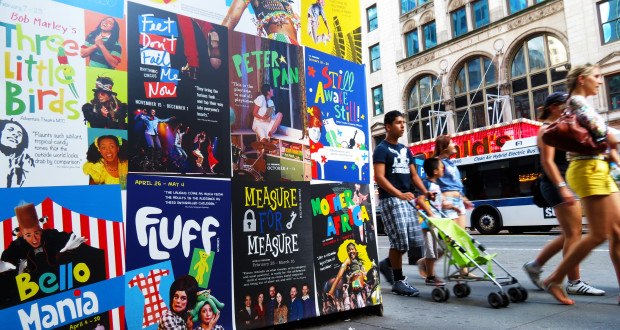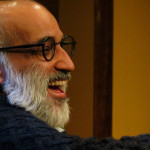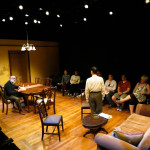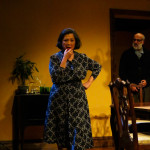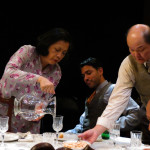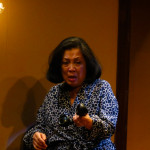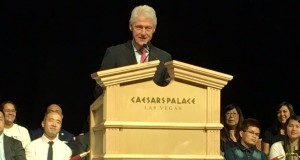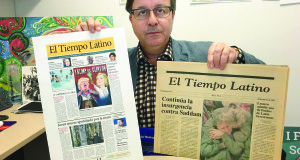They can sing and dance without so much as a huff or puff for air. They re-create the African savanna with agile giraffes and mighty lions that merge man and animal. They even make Disney dreams come true.
The talent of actors in theaters in New York City is as limitless as the human imagination. Yet it appears those under the spotlight fall under a certain breed of performers.
In the past six years, 79 percent of actors in Broadway and nonprofit theater companies have been Caucasian, according to the Asian American Performers Action Coalition. Only 3 percent were Asian American.
AAPAC is aiming to drive that share up.
At the forefront of AAPAC’s efforts is Christine Toy Johnson, a name many theater actors and veterans recognize. The actress, known for playing Dolly Levi in “Hello, Dolly!” by the National Asian Artists Project, Ethel Toffelmier in the Broadway revival of “The Music Man” and Erzulie in “Once on This Island,” has also donned the hat in advocating equal representation for Asian American actors.
Johnson says she has been “talking about issues with industry leaders who might be in the position to change things, hiring, writing plays that show we are American citizens who want to be included in the landscape of storytelling in America.”
One such case was when a white actor played an Asian role in the production of “The Nightingale” by the La Jolla Playhouse in San Diego — a decision Johnson has publicly criticized.
The debate of casting Asian American actors in a play is an old one, as they are often stereotyped for only Asian parts or Asian themes. A cursory look at the many marquees in New York’s Theater District found there are no Asian American leads on Broadway today
Upstaging stereotypes
“It kind of weighs on you. It’s empowering as an actor of color to do this role, nobody else gives you the chance to do such roles.”
– Sanjit De Silva
Mia Katigbak, an Asian American actress and a theater veteran, said the limited set of roles that were being offered to actors of her race 25 years ago motivated her to step outside the casting boundaries and create an opportunity for actors like herself. That eventually led to the creation of the National Asian American Theatre Company.
“It’s still a struggle to get commercial, big-money theaters to hire Asian American actors,” Katigbak says.
Asian American actors can also face an uphill institutional battle.
Performers need to be registered with Actors’ Equity, a labor union that offers registered actors preference at various auditions. However, to get preference requires a strong résumé — with opportunities that are often passed over to white actors.
NAATCO has recognized the need to offer Asian American actors that opportunity and decided to mix up the racial makeup of its production of Clifford Odet’s classic “Awake and Sing!”
The play, which premiered on Broadway in 1935 with an all-white cast, was reworked into an all-Asian lineup including Katigbak, who plays Bessie Berger, a mother with a penchant for order.
The character of Moe Axelrod in the play is depicted as a sharp-tongued mid-30s man with a secret love interest and walks with a distinct limp. The character, played by Sanjit De Silva, is a young man in his early 30s, his facial stubble and thin moustache giving him an older appearance that offsets his sharp looks that are of South Asian descent. De Silva has often been confused as Middle Eastern and said he has been routinely turned down roles for being “too fair for the part or too dark.” That changed when he got the part for “Awake and Sing!”
“I’m finally in a room where I’m with a group of actors, where I don’t have to explain myself,” he says. “It kind of weighs on you. It’s empowering as an actor of color to do this role, nobody else gives you the chance to do such roles.”
- Commuters pass a poster advertising Broadway and Off Broadway shows at Times Square 42 street, N.Y., on August 10, 2013. (AAJA Photo/Dipti Kumar)
- The New Amsterdam Theatre at 42 street, N.Y., is located in the theatre district and was built in 1903. (AAJA Photo/Dipti Kumar)
- Alok Tiwari enacts the role of the Jacob, a classical music loving father of Bessie Berger played by Mia Katigbak during rehearsal on Friday August 16, 2013 at the Walkspace theatre, N.Y. (AAJA Photo/Dipti Kumar)
- Alok Tiwari and Jon Norman Schneider rehearse scene 1 of the Clifford Odet’s classic play Awake and Sing on Friday August 16, 2013 at the Workspace theatre in N.Y. (AAJA Photo/Dipti Kumar)
- Mia Katigbak rehearses the role of Bessie Berger in the play Awake and Sing by Clifford Odets at the Workspace theatre in N.Y on Friday August 16, 2013. Katigbak’ repertoire includes Broadway and television shows. (AAJA Photo/Dipti Kumar)
- Mia Katigbak, founder of the National Asian American Theatre Company rehearses the role of Bessie Berger in Clifford Odet’s revival of Awake and Sing at WalkerSpace theatre, N.Y., on Friday August 16,2013 . (AAJA Photo/Dipti Kumar)
- Mia Katigbak, Sanjit De Silva, Henry Yuk and Andrew Ramcharan Guilarte rehearse scene 3 of the Clifford Odet’s adaptation of Awake and Sing at Workspace theatre in New York City on Friday, august 16, 2013. The play was originally performed in 1935 with an all White cast. (AAJA Photo/Dipti Kumar)
- Mia Katigbak, founder of the National Asian American Theatre Company enacts the scene when she has to call 911 to inform about the death of her character’s father in the play Awake and Sing on Friday, August 16, 2013. (AAJA Photo/Dipti Kumar)
 VOICES Publishing from the AAJA National Convention
VOICES Publishing from the AAJA National Convention

